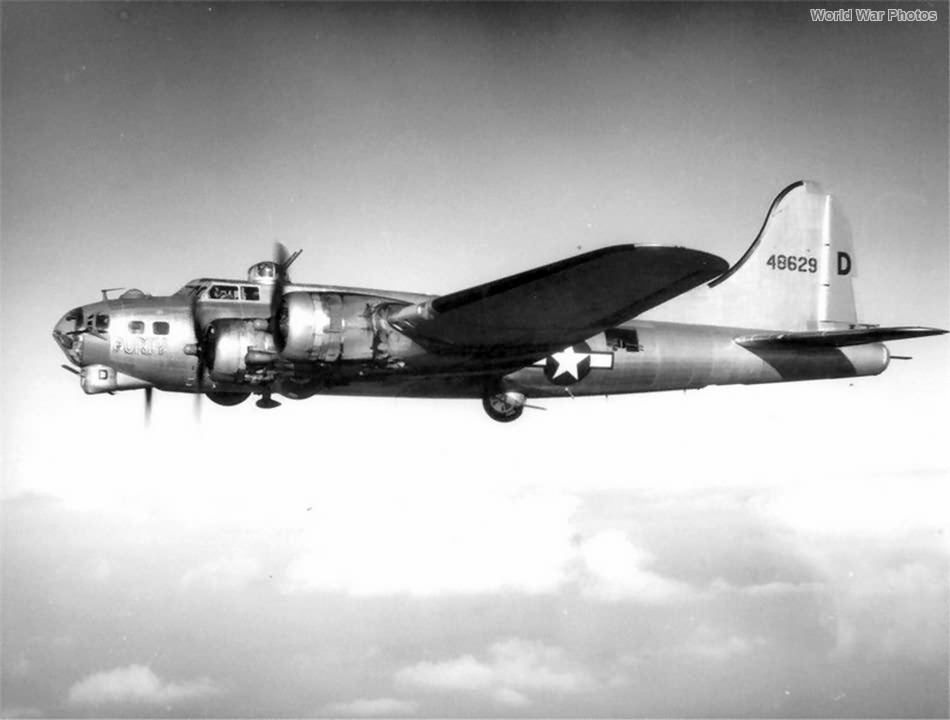The 34th Bomb Group (Heavy), known for its service with the Eighth Air Force during World War II, played a significant role in strategic bombing campaigns over Europe.
Assignment to the Eighth Air Force:
- Assigned Date: April 1944
- Wing & Command Assignments:
- 3rd Bomb Division, 93rd Combat Bomb Wing: April 1944
- 3rd Air Division, 93rd Combat Bomb Wing: January 1945
Component Squadrons:
- 4th Bombardment Squadron (H)
- 7th Bombardment Squadron (H)
- 18th Bombardment Squadron (H)
- 391st Bombardment Squadron (H)
Combat Aircraft:
- B-24 Liberators:
- B-24H (from blocks 15-CF and FO)
- B-24J: Used in combat until 24 August 1944
- B-17 Flying Fortresses:
- B-17G (from blocks 50-VE, 85-BO): Used in combat starting from 17 September 1944
Station:
- Mendlesham: April 18, 1944 – August 2, 1944 (Ground echelon stationed on April 26, 1944)
Commanding Officers:
- Col. Ernest J. Wackwitz Jr.: January 1944 – September 1944
- Col. William E. Creer: September 1944 – May 29, 1945
- Lt. Col. Eugene B. LeBailly: May 29, 1945 – August 1945
Operational History:
- First Mission: May 23, 1944
- Last Mission: April 20, 1945
- Total Missions: 170 (62 flown by B-24s)
- Total Credit Sorties: 5,713
- Total Bomb Tonnage: 13,424.6 tons (including 131.6 tons of leaflets, etc.)
- Aircraft Missing in Action (MIA): 34
- Other Operational Losses: 39
- Enemy Aircraft Claims: 8-4-12 (8 destroyed, 4 probable, 12 damaged)
Major Achievements:
- The 34th Bombardment Group was the oldest USAAF bomb group to serve with the Eighth Air Force.
- Remarkably, the group did not lose a single bomber to enemy fighter action over enemy territory. The only losses occurred over their own base.
Early History:
- Activation: January 15, 1941, at Langley Field, Virginia.
- Initial Equipment: B-17s, with subsequent operations including anti-submarine patrols on the U.S. eastern seaboard.
- Training and Deployment: The group trained with B-24s for overseas duty starting in January 1944. The air echelon moved overseas beginning on March 31, 1944.
Subsequent History:
- Redeployment: The group redeployed to the U.S. in June and July 1945. The air echelon departed on June 19, 1945, while the ground echelon sailed from Southampton on August 6, 1945.
- Inactivation: The group was inactivated at Sioux Falls Army Air Field, South Dakota, on August 28, 1945.
Aircraft Markings:
B-24 Liberators (April-August 1944):
- Finish: Majority in Dark Olive Drab and Neutral Gray factory finish.
- Group Marking: A white ‘square’ (actually a rectangle) measuring 48 inches high by 60 inches wide. This marking was applied on the tail and sometimes extended onto the rudder.
- Call Letters: 18-inch high letters in yellow (below the tail number) on camouflaged aircraft and in black on bare metal aircraft.
- Squadron Markings: Colored propeller bosses—white (4th Squadron), yellow (7th Squadron), red (18th Squadron), and bright green (391st Squadron).
- 93rd Wing High-Visibility Markings: From late June 1944, the front third of the outer surfaces of tail fins were painted red.
B-17 Flying Fortresses (July 1944 – July 1945):
- Finish: Natural metal with 93rd Combat Bomb Wing red wing and tail bands.
- Tail Marking: The front third of the fin was painted red, with the tail number and individual call-letters in black.
- Squadron Color Markings: Propeller bosses painted in squadron colors; nose bands and rear fuselage stripes were added in squadron colors (white, yellow, red, and green).
Notable Deployments:
- The group received several B-24Hs from the 486th Bomb Group in July 1944 to serve as 93rd Wing lead aircraft, featuring distinctive red markings on the outer sides of fins and rudders.
